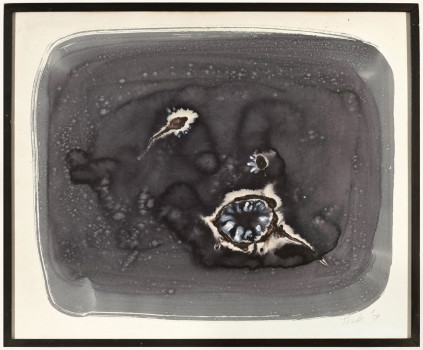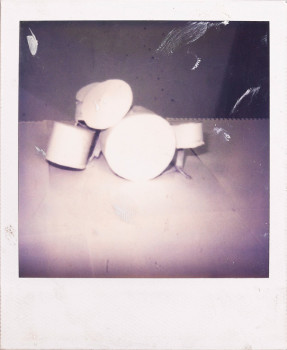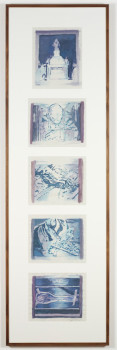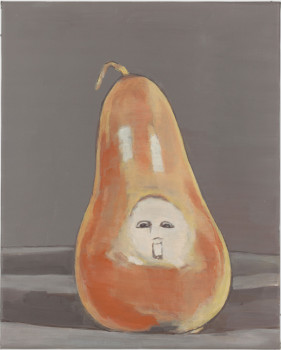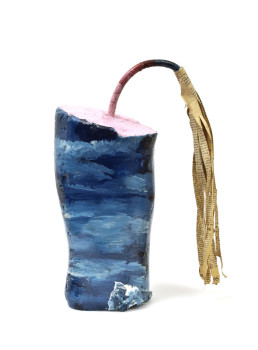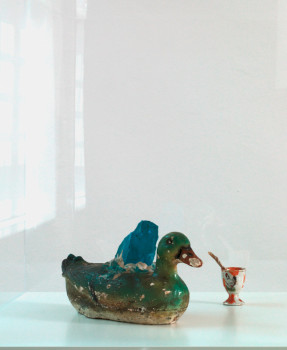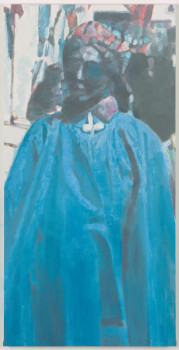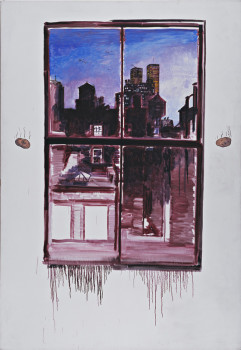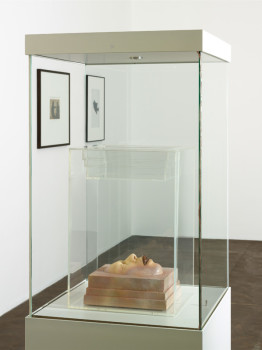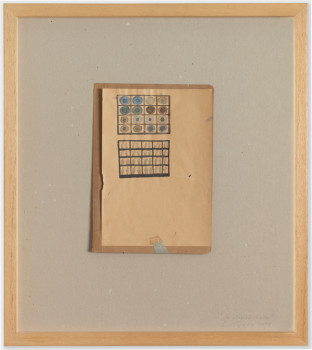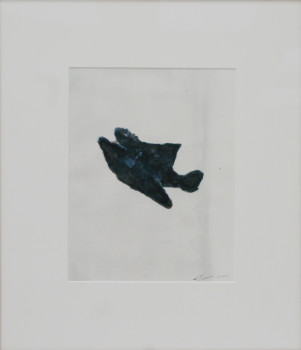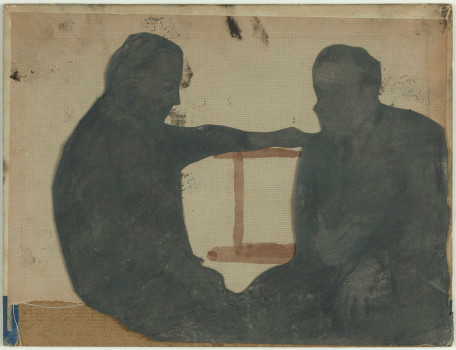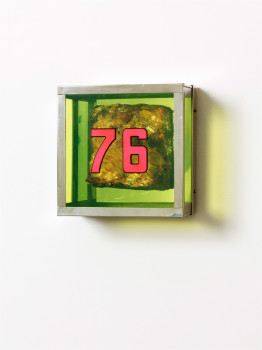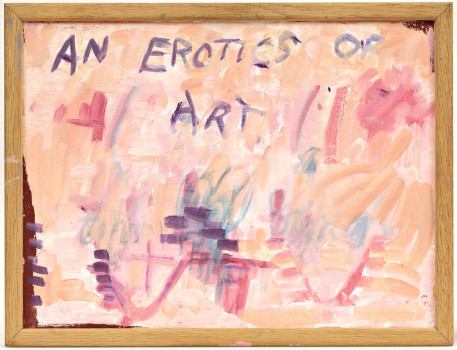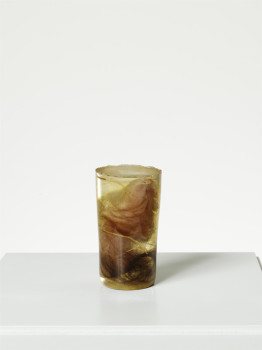Gallery exhibition
more about
Paul Thek & Luc Tuymans
Paul Thek; Untitled (from the series Technological Reliquaries); 1966
Wax, Plexiglas, Lack, melamin laminate, paint, metal; 216,5 x 24 x 24 cm; Deichtorhallen Hamburg / Falckenberg Collection
Paul Thek; Untiteled; 1970
Mixed media with concrete, iron, newspaper, lacquer, plaster, acryl; 36 cm high
Paul Thek; Cosmic Duck / Eggcup; 1968 / 69
Ceramic, plaster, paint, porcelain, feather, eggcup; Eggcup: 10,5 x 4 cm, Duck: 16,5 x 34 x 13,5 cm
Paul Thek; Untitled (Sodom & Gomorrha with Hot Potatoes); 1970 - 1971
Acrylic on canvas; 244,5 x 167 cm; Deichtorhallen Hamburg / Falckenberg Collection
Paul Thek; Pyramid Selfportrait; 1966 - 1967
Wax, metal, wood, plexiglas; 58 x 32 x 39,4 cm; Collection Kolumba, Cologne
Paul Thek; Untitled 76 (from the series Technological Reliquaries); 1964
Mixed media with wax in Plexiglas and aluminum box; 24 x 23 x 12 cm
In 1958, when Luc Tuymans was born, Paul Thek was twenty-five years old; when Tuymans was thirty, Thek died. Despite large-scale exhibitions in the major museums of the world, Thek’s oeuvre persists in insurmountable remoteness. It has been considered an example of a “private mythology” (Documenta 7, 1972) and has itself become a legend; Thek is referred to as an “artist’s artist”. Tuymans’s oeuvre, on the other hand, is firmly rooted in contemporary relevance, though only by insisting on its anachronism. It demands to be understood as an “authentic forgery”, radiating an aura of obsoleteness from the outset, and devoting itself to the interminable duration of a disastrous history and a present already bearing traces of its future decay.
In the 2010 exhibition “The Reality of the Lowest Rank” in Bruges, works by both artists were on view in close proximity. Tuymans, who was responsible for that show, employed as its title an expression by Tadeusz Kantor which conjures up the formless or unformed aspect of reality manifested in raw matter, base and abased existence, refuse and the booty of scavengers. For the show “Why?!” at Galerie Czarnowska, Tuymans again chose the works – his own and those by Paul Thek, dating from 1978 onwards in the one case and 1958 onwards in the other. The majority were borrowed from public and private collections; two new Tuymans works, however, will come directly from the studio. It was Tuymans’s wish to make this exhibition happen; he spoke of a measurable distance between his works and those of Paul Thek.
If the body is a yardstick, then distance is measured by the body’s destruction. Thek excavates the flesh beneath the skin, transporting clumps of the bloody, soft and alien interior to the surface. They are extracted parts, more liquid than solid, particular manifestations of visceral impalpability. Preoccupation with the lost, timeless, identity-less reality of flesh translates the desire to be outside oneself. Yet the lumps are subjected to enclosure in presentation apparatuses made of Plexiglas and aluminium, technological substitutes for surface and form, numbered with the year of the American Declaration of Independence. The bloody shred is a relic endowed with holiness; the glazing, however, revokes the promise of the flesh. In consequence, phantasms of the dismembered body anticipate its decomposition. A tragic quality is conveyed; it is as if the ecstasy of the flesh could be attained only at the cost of death. Thek figures himself as Death in a pink suit, as evidenced in the show by the Pyramid Self-Portrait (1966-67).
The historical consciousness identifies the agents conducting the bodies’ destruction: Nazi criminals who experiment and exterminate; the “diagnostic perspective” which classifies the symptoms; the “beautiful white boy”, heir to Belgian colonial rule and responsible for the torture and murder of Patrice Lumumba. That is the kind of knowledge that determines the bodies painted by Tuymans. Body is a shell with a zipper “with which it can be opened in order to stuff it and give it volume and meaning, to make it alive or more alive”.
For Tuymans, the relic is associated with a feeling of memory loss. Not the ahistorical reality of torn-out flesh but the traces left behind, images and ornaments of history, are his examples of reality of the lowest rank. The flesh which is missing from Body, however, is realized in and with the painting itself, the gropingly, haltingly executed distribution of the waxy paints.
What is measurable is the distance between the fatal ecstasy of the flesh and the desperate affirmation of bodily destruction through the carnality of painting.
Ulrich Loock
Paul Thek war 25 Jahre alt, als Luc Tuymans im Jahr 1958 geboren wurde; als Tuymans 30 Jahre alt war, starb Thek. Trotz großer Ausstellungen in den wichtigen Museen der Welt verharrt das Werk von Thek in unüberwindlicher Ferne. Es galt als Beispiel für eine „private Mythologie“ (Documenta 7, 1972) und ist selbst zum Mythos geworden; Thek wird als „Artist’s Artist“ bezeichnet. Das Werk von Tuymans hingegen steht mitten in der gegenwärtigen Aktualität, doch nur, indem es auf seinem Anachronismus besteht. Es will als „authentische Fälschung“ verstanden werden, gibt sich von vornherein veraltet, den unabschließbaren Momenten der katastrophischen Geschichte und einer Gegenwart zugewendet, die bereits von ihrem künftigen Verfall angehaucht ist.
In der Ausstellung „The Reality of the Lowest Rank“ in Brügge (2010) waren nahe beieinander Arbeiten von beiden zu sehen. Tuymans war für diese Ausstellung verantwortlich und hat als Titel einen Ausdruck von Tadeusz Kantor eingesetzt, der das Formlose oder Ungeformte der Wirklichkeit aufruft, welches sich in roher Materie, niedriger und erniedrigter Existenz, den weggeworfenen und zusammengesammelten Dingen manifestiert. Tuymans hat auch die Werke für die Ausstellung „Why?!“in der Galerie Czarnowska ausgesucht, seine eigenen ebenso wie die von Paul Thek, zurückgehend bis 1978 beim einen, bis 1958 beim anderen. Die meisten Arbeiten sind von öffentlichen und privaten Sammlungen ausgeliehen, zwei neue Bilder von Tuymans aber kommen direkt aus dem Atelier. Es war sein Wunsch, diese Ausstellung zu machen; er hat von einer messbaren Distanz zwischen seinen Sachen und denen von Paul Thek gesprochen.
Wenn der Körper ein Maßstab ist, bemisst sich die Distanz an seiner Zerstörung. Thek gräbt das Fleisch unter der Haut hervor und trägt Klumpen des blutigen, weichen und fremden Inneren nach außen. Es sind herausgelöste Teile, eher flüssig als fest, partikularer Ausdruck für viszerale Ungreifbarkeit. Die Hinwendung zur verlorenen, zeit- und identitätslosen Realität des Fleisches übersetzt das Begehren, außer sich zu sein, doch die Brocken müssen sich in Präsentationsapparate aus Plexiglas und Aluminium einfassen lassen, technologischen Ersatz für Oberfläche und Form, nummeriert mit der Jahreszahl der amerikanischen Unabhängigkeitserklärung. Der blutige Fetzen ist eine Reliquie, in welcher das Heilige anwesend ist; die Verglasung aber nimmt das Versprechen des Fleisches zurück. Als Folge greifen Phantasmen des zerstückelten Körpers auf dessen Zerfall voraus; tragisch scheint es, als sei die Ekstase des Fleisches nur um den Preis des Todes zu gewinnen. Thek verkörpert dessen Gestalt in rosafarbenem Anzug, in der Ausstellung belegt durch das Pyramid Self-Portrait (1966-67).
Das geschichtliche Bewusstsein identifiziert die Agenten, welche die Zerstörung der Körper betreiben: Naziverbrecher, die experimentieren und vernichten; der „diagnostische Blick“, der die Symptome klassifiziert; der „schöne weiße Junge“, Erbe der belgischen Kolonialherrschaft und verantwortlich für die Folterung und Ermordung von Patrice Lumumba. Solches Wissen bestimmt die Körper, die Tuymans malt. Body ist eine Hülle mit Reißverschluss, „mit dem man sie öffnen kann, um sie auszustopfen und ihr Volumen, ihr eine Bedeutung zu geben, um sie lebendig oder lebendiger zu machen“. Für Tuymans ist die Reliquie mit einem Gefühl des Gedächtnisverlustes verbunden. Nicht die ahistorische Wirklichkeit des herausgerissenen Fleisches, sondern die zurückgebliebenen Spuren, Bilder und Dekors der Geschichte gehören für ihn zur Realität des niedrigsten Ranges. Das Fleisch aber, das dem Körper von Body fehlt, wird in und mit der Malerei selbst realisiert, der tastend und stockend vorangetriebenen Verteilung der wächsernen Farben.
Die Distanz ist messbar zwischen tödlicher Ekstase des Fleisches und der verzweifelten Bejahung körperlicher Zerstörung durch die Fleischlichkeit der Malerei.
Ulrich Loock

